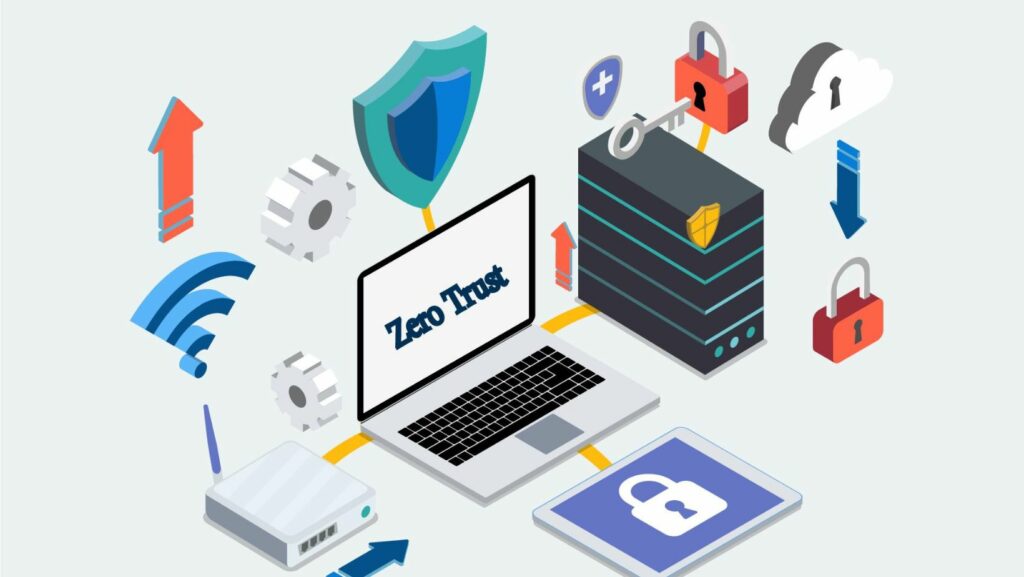
In today’s digital landscape, traditional security models can no longer protect organizations from sophisticated cyber threats. This is where the Microsoft Zero Trust model comes into play.
This article will guide you through the process of implementing Microsoft Zero Trust in your organization, helping you enhance your security posture and protect your valuable assets.
Understanding Microsoft Zero Trust
Before we discuss implementation, let’s first understand what Microsoft Zero Trust is and why it’s essential.
What is Microsoft Zero Trust?
Microsoft Zero Trust is a comprehensive security framework that assumes no trust by default. It verifies every access request regardless of where it originates or what resources it accesses.
This approach contrasts with traditional security models that trust users and devices within the corporate network.
Fundamental Principles of the Microsoft Zero Trust Model
- Verify explicitly
- Use the least privileged access
- Assume breach
These principles form the foundation of the Microsoft Zero Trust architecture, guiding how organizations approach security in a world where the network perimeter is no longer clearly defined.
Benefits of Implementing Microsoft Zero Trust
Adopting a Zero Trust Microsoft approach offers several benefits:
- Enhanced security posture
- Improved visibility and control
- Reduced risk of data breaches
- Better compliance with regulatory requirements
- Increased flexibility for remote and hybrid work environments
Steps to Implement Microsoft Zero Trust in Your Organization
Now that we understand the basics let’s look at how you can implement Microsoft Zero Trust in your organization.
Assess Your Current Environment
Before implementing zero trust Microsoft, you need to understand your current security posture:
- Identify your critical assets and data
- Map out your existing network infrastructure
- Review current access policies and controls
- Evaluate your current security tools and technologies
Define Your Microsoft Zero Trust Strategy
Based on your assessment, develop a strategy for implementing Microsoft Zero Trust:
- Set clear goals and objectives
- Prioritize areas for implementation
- Define success metrics
- Create a roadmap for implementation
Implement Strong Identity and Access Management
Identity is a cornerstone of the Microsoft Zero Trust model:
- Implement multi-factor authentication (MFA) across your organization
- Use conditional access policies to enforce context-based access controls
- Implement just-in-time and just-enough-access principles
- Regularly review and update user access privileges
Secure Devices and Endpoints
Ensure all devices accessing your resources are secure:
- Implement endpoint detection and response (EDR) solutions
- Use mobile device management (MDM) for BYOD scenarios
- Regularly update and patch all devices
- Implement device health checks before granting access
Protect Applications and APIs
Secure your applications and APIs in line with Microsoft Zero Trust principles:
- Implement application-level firewalls
- Use API gateways to control and monitor API access
- Implement runtime application self-protection (RASP)
- Regularly conduct security testing and code reviews
Secure Network Access
While the network is no longer the primary security perimeter in a zero-trust model, it still plays a crucial role:
- Implement network segmentation
- Use software-defined networking (SDN) for granular control
- Implement encryption for all network traffic
- Use virtual private networks (VPNs) or Zero Trust Network Access (ZTNA) solutions for remote access
Protect Data
Data protection is a critical component of the Microsoft Zero Trust architecture:
- Implement data classification and labeling
- Use encryption for data at rest and in transit
- Implement data loss prevention (DLP) policies
- Use rights management services to control data access and usage
Visibility and Analytics
Implement robust monitoring and analytics capabilities:
- Use Security Information and Event Management (SIEM) solutions
- Implement User and Entity Behavior Analytics (UEBA)
- Regularly conduct security audits and assessments
- Use Microsoft Defender for Cloud Apps for cloud app security
Automation and Orchestration
Leverage automation to enhance your Zero Trust implementation:
- Implement automated policy enforcement
- Use orchestration tools for incident response
- Automate routine security tasks and updates
- Implement continuous monitoring and adaptive policies
Education and Training
Ensure your team understands and supports the Zero Trust Microsoft approach:
- Conduct regular security awareness training
- Provide specialized training for IT and security teams
- Develop and communicate clear security policies and procedures
- Foster a culture of security within your organization
Overcoming Challenges in Microsoft Zero Trust Implementation
Implementing Microsoft Zero Trust can be challenging. Here are some common obstacles and how to overcome them:
Resistance to Change
- Communicate the benefits of Zero Trust clearly
- Involve stakeholders early in the planning process
- Implement changes gradually to minimize disruption
Legacy Systems
- Prioritize modernization of critical systems
- Use proxies or gateways to extend Zero Trust principles to legacy systems
- Plan for phased replacement of incompatible systems
Complexity
- Start with small, manageable projects
- Use integrated solutions to reduce complexity
- Leverage Microsoft’s Zero Trust assessment tools and guidance
Cost
- Prioritize investments based on risk and potential impact
- Consider cloud-based solutions for more flexible pricing models
- Leverage existing Microsoft licenses and tools where possible
Coolest Practices for Microsoft Zero Trust Implementation
To ensure success with your Microsoft Zero Trust implementation, consider these best practices:
- Start with a clear understanding of your business objectives and risk tolerance
- Adopt a phased approach, focusing on quick wins early
- Continuously monitor and adjust your Zero Trust policies and controls
- Regularly test your Zero Trust implementation through penetration testing and red team exercises
- Stay informed about evolving threats and Zero Trust best practices
- Leverage Microsoft’s extensive Zero Trust resources and guidance
- Consider partnering with experienced Zero Trust consultants or managed service providers
The Future of Microsoft Zero Trust
As cyber threats continue to evolve, so too will the Microsoft Zero Trust model. Here are some trends to watch:
- Increased integration of artificial intelligence and machine learning
- Greater emphasis on user and entity behavior analytics
- Evolution of Zero Trust for IoT and edge computing scenarios
- Enhanced integration with cloud services and multi-cloud environments
- Development of industry-specific Zero Trust frameworks and guidelines
Conclusion
Implementing Microsoft Zero Trust in your organization is a journey that requires careful planning, execution, and ongoing management.
By following the steps and best practices outlined in this article, you can enhance your security posture, protect your valuable assets, and build a more resilient organization.
Remember that Zero Trust is not a one-time project but an ongoing continuous improvement process. Stay committed to its principles, leverage Microsoft’s tools and resources, and remain vigilant against evolving threats.
By embracing the Microsoft Zero Trust model, you’re not just implementing a new security framework – you’re transforming your approach to cybersecurity to serve your organization well into the future.
Start your Zero Trust journey today and proactively protect your digital assets in an increasingly complex threat landscape.












